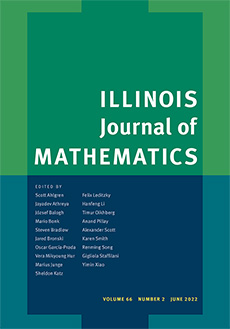Abstract
A network is a countable, connected graph $X$ viewed as a one-complex, where each edge $[x,y]=[y,x]$ ($x,y\in X^0$, the vertex set) is a copy of the unit interval within the graph's one-skeleton $X^1$ and is assigned a positive conductance $\mathsf{c}(xy)$. A reference "Lebesgue" measure $X^1$ is built up by using Lebesgue measure with total mass $\mathsf{c}(xy)$ on each edge $xy$. There are three natural operators on $X$: the transition operator $P$ acting on functions on $X^0$ (the reversible Markov chain associated with $\mathsf{c}$), the averaging operator $A$ over spheres of radius~1 on $X^1$, and the Laplace operator $\Delta$ on $X^1$ (with Kirchhoff conditions weighted by $\mathsf{c}$ at the vertices). The relation between the $\ell^2$-spectrum of $P$ and the $H^2$-spectrum of~$\Delta$ was described by {Cattaneo} \cite{Cat}. In this note we describe the relation between the $\ell^2$-spectrum of $P$ and the $L^2$-spectrum of $A$.
Citation
Donald I. Cartwright. Wolfgang Woess. "The spectrum of the averaging operator on a network (metric graph)." Illinois J. Math. 51 (3) 805 - 830, Fall 2007. https://doi.org/10.1215/ijm/1258131103
Information





